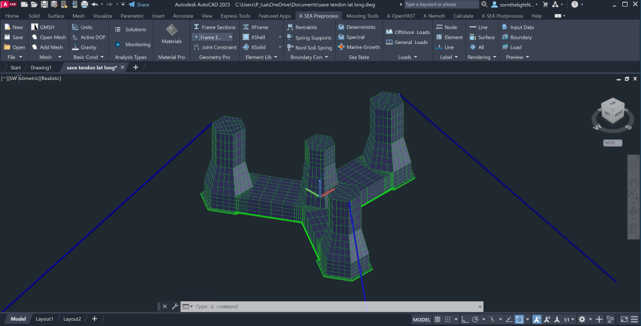

The X-WIND software aims to provide a complete solution for analyzing and optimizing the offshore wind turbine system. It performs turbine analysis, structural analysis, and diffraction/radiation analysis in the Autocad frame.
From the current version, the X-Wind can be used free for 3 months without license. For the commercial and academic use, please keep in touch with Prof. Kim Ki-Du (kimkd@konkuk.ac.kr) to get the license.
Download
X-WIND V2.01ut (Free License)

Unleashing Web-Based Engineering Solutions for Offshore Structures, Wind Farms, and Sustainable Energy: Explore Innovative Software Tools, from Integrated Finite Element Analysis to OpenFAST's Multi-Turbine Simulation.
We provide a unique and comprehensive tool for structure modeling that can model both in 2D and 3D.
The designed model could be viewed in 3D with the real shape and dimension of each memeber.
Real animation of the wind turbine structure is simulated using the analyzed data.
The most up to date engine generates an accurate and detail analysis result.
Graph plots could be viewed after anaylysis is done.
Lorem ipsum dolor sit amet, consectetur adipisci elit, sed eiusmod tempor incidunt ut labore et dolore magna aliqua. Ut enim ad minim veniam, quis nostrum exercitationem ullam corporis suscipit laboriosam, nisi ut aliquid ex ea commodi consequatur. Quis aute iure reprehenderit in voluptate velit esse cillum dolore eu fugiat nulla pariatur. Excepteur sint obcaecat cupiditat non proident, sunt in culpa qui officia deserunt mollit anim id est laborum.
Lorem ipsum dolor sit amet, consectetur adipisci elit, sed eiusmod tempor incidunt ut labore et dolore magna aliqua. Ut enim ad minim veniam, quis nostrum exercitationem ullam corporis suscipit laboriosam, nisi ut aliquid ex ea commodi consequatur. Quis aute iure reprehenderit in voluptate velit esse cillum dolore eu fugiat nulla pariatur. Excepteur sint obcaecat cupiditat non proident, sunt in culpa qui officia deserunt mollit anim id est laborum.
All users are eligible for a free X-Wind license for a duration of 3 months. To continuously use the X-Wind for thesis, teaching purposes or commercial purpose, please briefly describe your message below. Please note that the trial version of X-Wind is not permitted for commercial purposes.
 kimkd@konkuk.ac.kr
kimkd@konkuk.ac.kr www.xfinas.com
www.xfinas.com